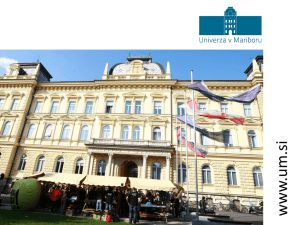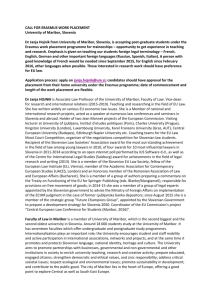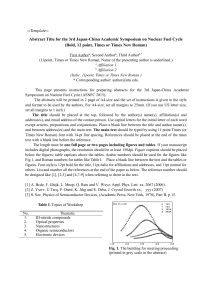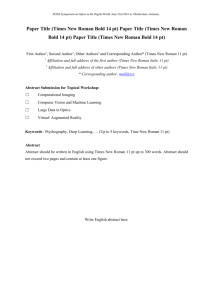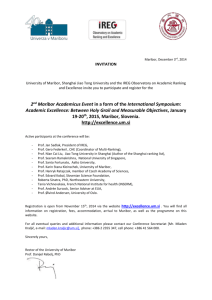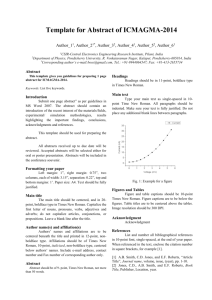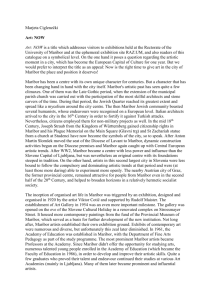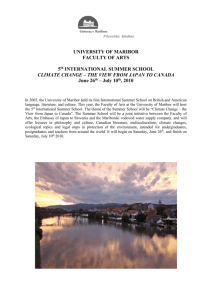Angle*ka predloga za KE
advertisement
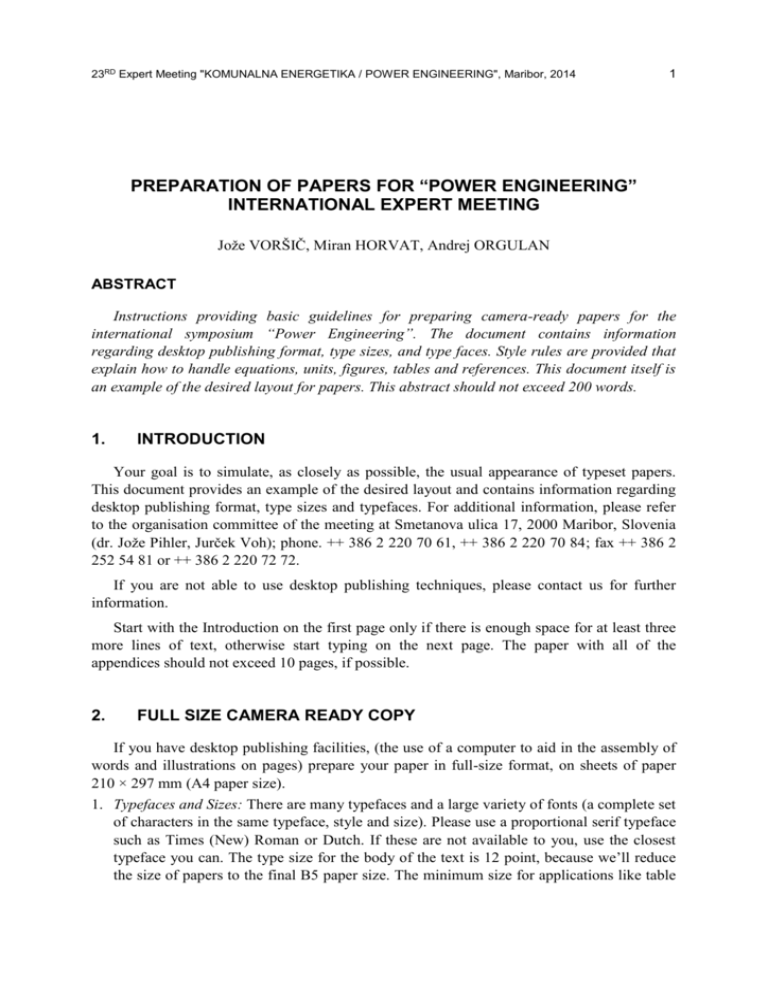
23RD Expert Meeting "KOMUNALNA ENERGETIKA / POWER ENGINEERING", Maribor, 2014 1 PREPARATION OF PAPERS FOR “POWER ENGINEERING” INTERNATIONAL EXPERT MEETING Jože VORŠIČ, Miran HORVAT, Andrej ORGULAN ABSTRACT Instructions providing basic guidelines for preparing camera-ready papers for the international symposium “Power Engineering”. The document contains information regarding desktop publishing format, type sizes, and type faces. Style rules are provided that explain how to handle equations, units, figures, tables and references. This document itself is an example of the desired layout for papers. This abstract should not exceed 200 words. 1. INTRODUCTION Your goal is to simulate, as closely as possible, the usual appearance of typeset papers. This document provides an example of the desired layout and contains information regarding desktop publishing format, type sizes and typefaces. For additional information, please refer to the organisation committee of the meeting at Smetanova ulica 17, 2000 Maribor, Slovenia (dr. Jože Pihler, Jurček Voh); phone. ++ 386 2 220 70 61, ++ 386 2 220 70 84; fax ++ 386 2 252 54 81 or ++ 386 2 220 72 72. If you are not able to use desktop publishing techniques, please contact us for further information. Start with the Introduction on the first page only if there is enough space for at least three more lines of text, otherwise start typing on the next page. The paper with all of the appendices should not exceed 10 pages, if possible. 2. FULL SIZE CAMERA READY COPY If you have desktop publishing facilities, (the use of a computer to aid in the assembly of words and illustrations on pages) prepare your paper in full-size format, on sheets of paper 210 × 297 mm (A4 paper size). 1. Typefaces and Sizes: There are many typefaces and a large variety of fonts (a complete set of characters in the same typeface, style and size). Please use a proportional serif typeface such as Times (New) Roman or Dutch. If these are not available to you, use the closest typeface you can. The type size for the body of the text is 12 point, because we’ll reduce the size of papers to the final B5 paper size. The minimum size for applications like table 23RD Expert Meeting "KOMUNALNA ENERGETIKA / POWER ENGINEERING", Maribor, 2014 2 captions, footnotes, and text subscripts is 10 point. Try to follow the type sizes specified in Table I. As an aid to gauging type size, here are some examples: This is similar to Times Roman 10 points normal. This is similar to Times Roman 11 points normal. This is similar to Times Roman 12 points normal. This is similar to Times Roman 12 points bold. This is similar to Times Roman 13 points bold. Table I: Type size 10 11 12 13 14 Type Sizes for Camera Ready Papers Comments Subscripts and superscripts Footnotes, biography Main text, table and figure captions, subheadings and authors’ names Main headings Paper title Appearance Italic Bold Abstract Subheadings Headings Paper title 2. Format: In formatting your original A4 page, set top margin to about 40 mm, bottom margin to 25 mm and left and right margin to 25 mm. The text width is about 160 mm. 3. ADDITIONAL REQUIREMENTS 3.1 Figures and tables Figure captions should be below the figures; table captions should be above the tables. Avoid placing figures and tables before their first mention in the text. Use the abbreviation “Fig. 1,” even at the beginning of a sentence. Figure axis labels are often a source of confusion. Try to use words rather than symbols. As an example, write the quantity “Voltage”, or “Voltage, U,” not just “U.” Put units in parentheses. Do not label axes only with units. 23RD Expert Meeting "KOMUNALNA ENERGETIKA / POWER ENGINEERING", Maribor, 2014 55 mm 35 mm 160 mm 160 mm 25 mm 25 mm 30 mm 3 30 mm Fig.1. Formatting of A4 paper size 3.2 Numbering Number reference citations consecutively in square brackets [1]. Refer simply to the reference number, as in [2]. Do not use “Ref. [2]” or “reference [2]”. Do not number pages! 3.3 Abbreviations and Acronyms Define abbreviations and acronyms the first time they are used in the text, even after they have been defined in the abstract. Abbreviations such as IEEE, SI, ac, dc and rms do not have to be defined. Do not use abbreviations in the title unless they are unavoidable. 3.4 Equations Number equations consecutively with equation numbers in parentheses flush with the right margin, as in (1). To make your equation more compact, you may use the solidus ( / ), the exp function, or appropriate exponents. Italicize Roman symbols for quantities and variables, but not Greek symbols. Use long dash rather than a hyphen for a minus sign. Use parentheses to avoid ambiguities in denominators. Punctuate equations with commas or periods when they are part of a sentence. L s dl D1 0 R where: (1) L - length of leakage path, dl - element of leakage path D1 - diameter of surface at dl 4 23RD Expert Meeting "KOMUNALNA ENERGETIKA / POWER ENGINEERING", Maribor, 2014 Be sure that the symbols in your equation have been defined before the equation appears or immediately following. Use “(1),” not “Eq. (1)” or “equation (1),” except at the beginning of a sentence: “Equation (1) is ...” 4. REFERENCES References are important to the reader; therefore, each citation must be complete and correct. There is no editorial check on references, therefore an incomplete or wrong reference will be published unless caught by a reviewer or discusser and will detract from the authority and value of the paper. Reference to books and papers by authors other than the author are encouraged. [1] J. Voršič, V. Muzek and A. Orgulan, “Influence of the network development on the voltage waveform distortion,” Proceedings of the second International Conference on Power Quality, 1992, pp C-24:1-7. [2] J. Voršič, V. Kranjc, J. Krope and E. Grilc, “Vroča voda ali plin - dilema snovalcev komunalne energetike,” Proceedings of the second International Expert Meeting on Power Engineering, Maribor 1992, pp 15-30. AUTHORS’ ADDRESS Assoc. Prof. Ph.D. Jože Voršič Andrej Orgulan, B.Sc.E. Miran Horvat, B.Sc.E. University of Maribor, Faculty of Electrical Engineering and Computer Science Smetanova ulica 17, 2000 Maribor, Slovenia Tel: + 386 2 220 70 50 Fax: + 386 2 252 54 81 or + 386 2 251 11 78 Email: power.eng@uni-mb.si
